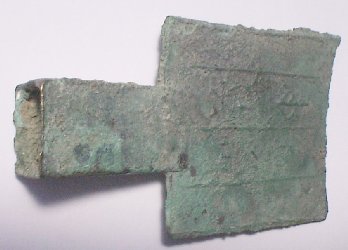
Hollow-shaft spade coin. Ding 63. Ji Fu Xiao Hua.

Hollow-shaft spade coin. Ding 63. Ji Fu Xiao Hua.


Pointed Knife without characters. Schjöth 62-64v or Ding 336-338v. 13,32 gr.


Straight back knife with one character (Which?) Ding 346v. 8,64 gr.

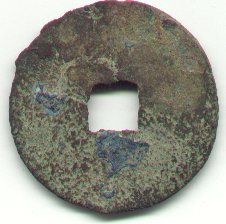
Schjöth 70/Ding 440. Yi Liu Hua. 9,70 gr.
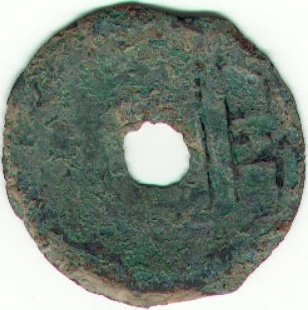
Schjöth 73 Round hole coin. 8,92 gr.
Character is Yuan
![]() ,
which means wall and was a city in the state of Wei.
,
which means wall and was a city in the state of Wei.


Ban Liang from Qin kingdom of Warring
States. 5,15 gr. 31 m.m.
Note the rounded "fork" in Ban. According to the catalog Monnaies
Chinoises
by F. Thierry p. 256 nr. 486-487 it seems to be from a local mint from the last
half of The Warring
States period (336-221 b.c.).


Ban Liang with long script from Qin kingdom of Warring States. ?,?? gr. 32 m.m.


Schjöth 79/Ding 386. Ban Liang. 4,4 gr. 36 m.m.


Qin Ban Liang, medium size. Ren 47. 7,1 gr. 32 m.m.


3,0 gr. 24 m.m.
Same type as above but iron. The earliest type of iron coin in China.
No references in catalogues. Unearthed in Sichuan.


Ban Liang. 3,4 gr. 24 m.m.
Same type as above but Lead.
Unearthed in Xian, Shaanxi province.


Ding 535. Da Quan Dang Qian. 11,7 gr.
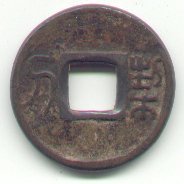
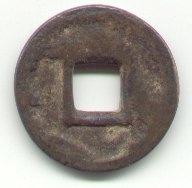
Schjöth 117 Ding 457. Qi Dao. This round coin is similar to the round
top of Wang Mang's knife coin (Ding 455), only without the blade.


Ding 559. Han Xing.
Minted by Li Shou in the Han Xing year period between A.D. 338-343.
This is Chinas earliest year period coin (Peng Xinwei p.188).


Schjöth 211 Ding 554. Feng Huo.
Minted by the rebel Shi Le, king of the later Zhao kingdom. A.D. 273-332.


Schjöth 218 Ding 567. Xiao Jian Si Zhu
![]() .
Very light light and thin, 1,4 gr.
.
Very light light and thin, 1,4 gr.
Xiao Jian was the first reign title (A.D. 454-457) of emperor Xiao Wu who
reigned A.D. 454-465.



Ding 666. Tai
Qing Feng Le ![]() . It was cast between 547 and 549 A.D. during
the
. It was cast between 547 and 549 A.D. during
the
T'ai Qing reign-title period. In Ding it is referred to as Tian Qing Feng Le,
but if
one takes a look at Tai Huo Liu Zhu from this period,
which everyone seems to agree is tai, one will see that it
has tai written exactly this way. But maybe both coins are tian.


Schjöth 243 Ding 599. Tai Huo Liu Zhu (Six
Zhu) ![]() .
Minted in A.D. 579 in the period of Emperor Xuan (A.D. 569-583). It circulated
alongside the Wu Zhu, and in the beginning it had the same value as 10 Wu Zhu.
.
Minted in A.D. 579 in the period of Emperor Xuan (A.D. 569-583). It circulated
alongside the Wu Zhu, and in the beginning it had the same value as 10 Wu Zhu.


Schjöth 237. Ding 600. Tai He Wu Zhu
![]() . 2,6
gr.
. 2,6
gr.
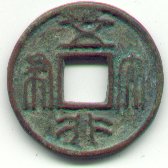

Schjöth 246 Ding 640. Wu Xing Da Bu.


Schjöth 246 Ding 644. Yong Tong Wan Guo.
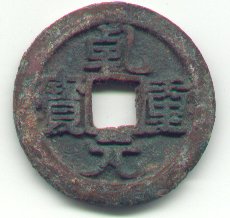

Schjöth 355 Ding 693v. Qian Yuan Zhong Bao. With double inner rim on reverse.


Ding 793v. Qian Feng Quan Bao. 4,7 gr.
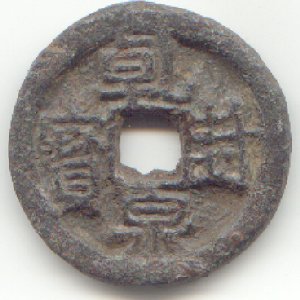
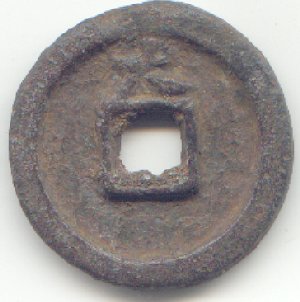
Schjöth 448v. Ding
796. Qian Feng Quan Bao.
Reverse Tian ![]() . Iron. 18,02 gr.
. Iron. 18,02 gr.
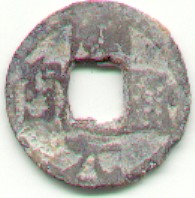

Ding 777. Lead. Kai Yuan Tong Bao. Reverse Min
![]() and a dot.
and a dot.
According to David Ren, both Min
![]() and Fu
and Fu ![]() refers to
Fujian.
refers to
Fujian.


No references. Kai Yuan Zhong Bao. Silver! A very
rare coin. 2,1 gr.
Excavated in 1984 from the tomb of the King of Southern Han in Guangzhou.


Schjöth 436v/Ding 828. Qian Heng Zhong Bao. Reverse Yong
![]() .
.
Lead, cast in Guangdong province. Worth 1/10 bronze coin.


Yong An Yi Bai. Iron. Issued by Liu Rengong
![]() in the end of
Southern Tang
in the end of
Southern Tang
when he occupied
Youzhou ![]() .
.


Schjöth 460. Tai Ping Tong Bao. But lead! Cast in Guangdong or Guangxi. 3,68
gr.


Schjöth 463v.Chun Hua Yuan Bao. Lead. 4,68 gr.


Schjöth 465v. Zhi Dao Yuan Bao. Lead. 4,69 gr.


Schjöth 469 but lead! Cast in Guangdong or Guangxi. 3,07 gr.


Ding 932. Zhi He Zhong Bao. Iron.


Schjöth 546. Yuan Feng Tong Bao. Lishu (clerk script).
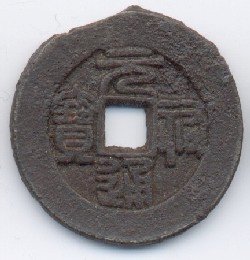
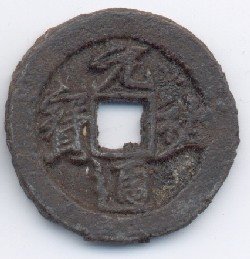
Schjöth 580. Iron. Yuan You Tong Bao. Schjöth 581. Iron. Yuan You Tong Bao.


Ding 1097. Xuan He Yuan Bao. A rare coin.


Schjöth 659.
Xuan He Tong Bao.


Shao Xi Tong Bao. One qian. Reverse chun and san. Iron.
Qichun mint.


Ding 1241 Schjöth 782. Shao Xi Tong Bao. Two qian.
Reverse chun
and san. Qichun mint. Iron.


Ding 1450. Sheng Song Zhong Bao. Iron. Reverse upper li yi
![]() below wu
below wu
![]() .
.


Ding 1451. Bao Qing Yuan Bao. Reverse crescent. Iron. Hanyang mint.


Schjöth 983. Duan Ping Tong Bao.


Ding 1503v. Duan Ping Tong Bao. Reverse wu hui and xia dong
![]() . Iron.
. Iron.


Schjöth. 1081. Huang Jian Yuan Bao.


Schjöth 1093 Ding 1661. Tai He Zhong Bao.


Schjöth 1111. Zhi Zheng Tong Bao.
Denomination 10 in Mongol script.
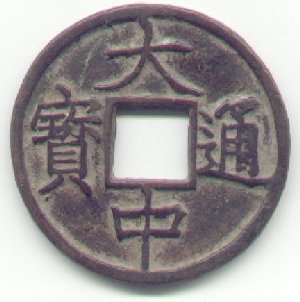

Schjöth 1134. Da Zhong Tong Bao. Value ten.


Schjöth 1143. Hong Wu Tong Bao.
Reverse Beiping (Beijing).

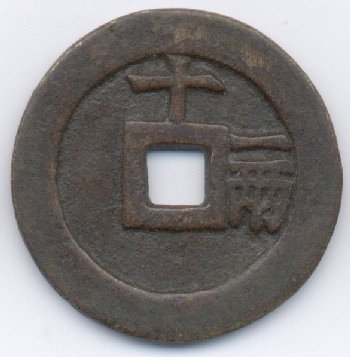
Schjöth 1223. Tian Qi Tong Bao. Eleven liang.

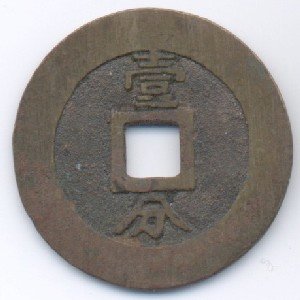
Schjöth 1321v. Yong Li Tong Bao. One fen.


Schjöth 1325. Yong Chang Tong Bao.


Schjöth 1334. Xing Chao Tong Bao. One fen (ten cash).
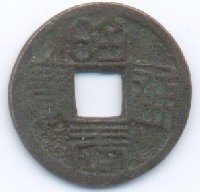
Schjöth 1344. Zhao Wu Tong Bao.


Schjöth 1355 Ding 2173. Old-style Manzu script. Reads left-right,top-bottom:
"Abkai fulingga han jiha." According to Ding the Chinese equivalent is
Tian Cong Tong Bao
![]() (Circulating
treasure of heavenly wisdom).
(Circulating
treasure of heavenly wisdom).
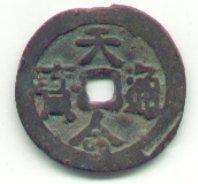

Schjöth 1356 Ding 2172. Tian Ming Tong Bao (Circulating treasure of heavenly
mandate).


Ding 2267. Tai
![]() ,
short for for Taiwan province.
,
short for for Taiwan province.


Xian Feng Tong Bao. Iron coin.
Krause 1801-1900. Empire, general issue s. 205. 1-4a.
Iron coins were issued by Xian Feng during the
Taiping rebellion,
because the war against the rebels caused a shortage of
cupper.


Ding 2520. 20 Yuan.

Thousand Character Classic coin set
![]() .
Mint of Ministery of Works.
.
Mint of Ministery of Works.
The characters are extracted from the Qian Zi Wen, the Thousand Character
Classic, which is an almost 1500 years old school primer consisting of exactly one thousand unique
characters. It was written in the Liang dynasty (A.D. 502-557) by the civil
servant Zhou Xingsi. The characters do not stand together in
the text, but appears in this order. The six characters sums up the meaning of
the first three lines of the text:
"In the universe the never ending days come and go".
See image
of first lines (read right-left, top-bottom).